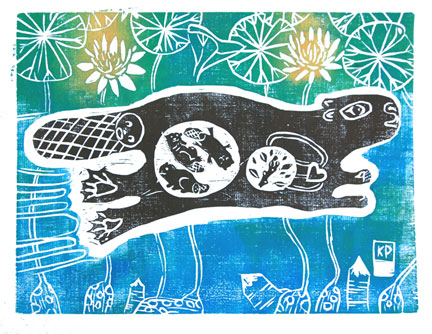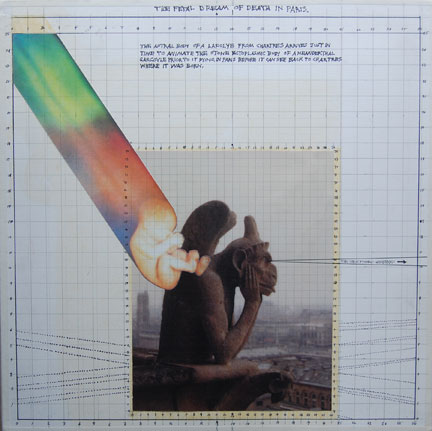Local Artists Stage Secret Guerilla Art Show at the MFA
By Kathleen Morrison
Looking at art often takes you to a different place. You can almost smell the paint, feel the cool breeze…hear the toilets flushing?
That was the case earlier this month at the Museum of Fine Arts as a group of twenty-one contemporary artists held a guerilla art show in a pair of bathrooms at the MFA.
The event, held June 15 at 7 p.m., both recreated and honored a similar showing from forty years ago, when just six artists snuck in their paintings, drawings, and small sculptures under their coats to make a point about contemporary art in the MFA. They called their show, Flush With the Walls.
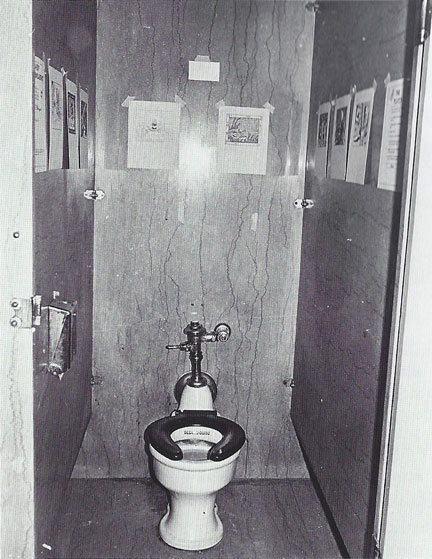
Image from the original bathroom show Flush With the Walls, in 1971.
Photo courtesy of The New England Journal of Aesthetic Research
At the time, the newspaper Boston After Dark wrote that the show “point[ed] out that the men’s room seems to be the only place in the Museum of Fine Arts that an exhibit by contemporary local artists can be seen.”
Local artist and art writer Greg Cook was inspired by Flush with the Walls “for both its humor and its daring.” As the forty-year mark approached, he began to entertain thoughts of doing it again.
“So as the anniversary was coming up, I just kept feeling like this was an amazing, legendary moment in Boston art, and also for the MFA,” Cook said in a speech at the event. “And I just kept feeling like it would be a real shame if the MFA and all of us couldn’t get together to celebrate this moment.”
Cook continued, saying, “So in that spirit, we’re here tonight. I rounded up twenty-one artists and art collectors from the Boston area. Again, we’re here tonight without permission from the MFA, sneaking in our prints and drawings and sculptures.”
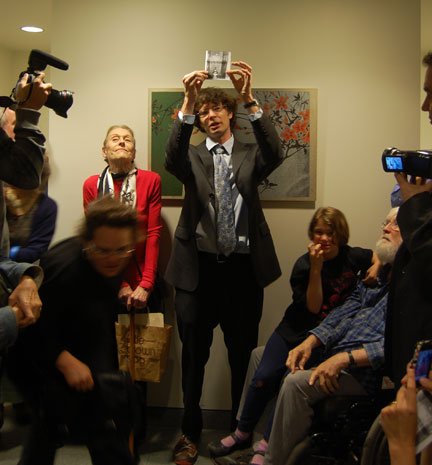
Greg Cook makes a speech at the event, flanked by artists Jo Sandman (left) and Bob Guillemin (right) as a museum patron tries to leave the bathroom.
Photo credit: Elizabeth Alexander, courtesy of The New England Journal of Aesthetic Research.
At 6:45 p.m. the artists began surreptitiously gathering in a small hallway outside the pair of bathrooms situated on a landing halfway between the new glass-encased atrium and the special exhibitions floor currently housing glassworks by Chihuly.
The timing, on a Wednesday night, was serendipitous – after 4 p.m. each Wednesday the MFA allows visitors in for a voluntary contribution rather than the typical admission fee, making it a popular and busy night.
As museum patrons made their way into the bathroom, they reacted with surprise and bewilderment to find a large group of people in and around the bathrooms and sculptures, installations and paintings displayed all over the restroom.
Most surprised of all, perhaps, were those that emerged from a stall to see a man in the women’s room—the show opened both rooms up to all genders.
Although at least one man left perturbed that his personal time was disturbed in such a colorful way, most patrons enjoyed the show. After her own surprise, visitor Sarah Gibbons loved seeing others’ reactions to the pieces. “I think its great. I think it reminds me of this library project where people snuck in library books into a library for circulation,” she said. “I think it’s a play of, ‘What is high art?’ and ‘What’s worth seeing?’ and how you are able to get the connections to have an exhibit in a place like this?”
Other guests came to the museum specifically for the bathroom show. Melissa Chandon was one such visitor, a student of artist Deb Todd Wheeler, who displayed pieces in the men’s room. Chandon found the energy of the show electrifying.
“I’ve been to gazillions of art openings, but this seems really vibrant and has a different kind of energy to it, because of the nature of it. And I think because, juxtaposed to where the location is in the bathroom, there’s kind of an irony,” Chandon said. “And it’s kind of like a scavenger hunt as well. I remember I went to an exhibition at the Louvre, and they had invited artists from all over the world to be part of a rotating exhibition, and it was like a scavenger hunt. You had to go find them. So I feel like there is an element of that to this, where you have to figure out, ‘Is that a piece? Is that part of it? Are there some in the toilets?’ It seems very Marcel Duchamp-like.”
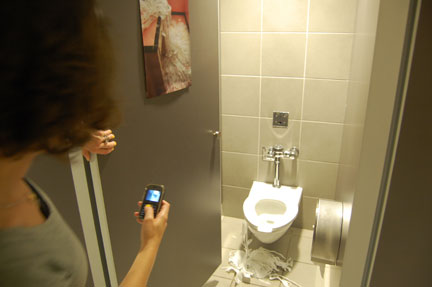
A guest takes a picture of Elizabeth Alexander’s installation.
Photo courtesy of The New England Journal of Aesthetic Research.
Although the exhibit paid homage to the energy and spirit of the original bathroom showcase, the vibe of the 1971 show reflected differences in the art world then and now.
“It was done by ignorant, happy, excited artists that wanted to create art that talked to a lot of people,” recalled artist Bob Guillemin—better known as Sidewalk Sam. “At that time the environment for art was very different than it is today. There were only a few registered, formal arenas for showing art and only art shown in those arenas was thought to be respected, and we thought that we would take a break from this respectable format and introduce our art into the MFA.”
Added Jo Sandman, another of the original six artists also showing work at this year’s show, “It was a guerilla show. We spent weeks and weeks and weeks planning it and we went in very stealth, with stuff under our raincoats. This is a wonderful action; it’s just not as dangerous as what we did.”
The original show attracted three or four hundred people, including press and TV cameras, but enjoyed this fame for only a short while. “Guards came in with a kind of a fierce, professional antagonism and tore the art down,” Guillemin remembered.
His granddaughter, sitting on his knee reading a comic book produced by Dan Moynihan for the bathroom show, asked him, “Why did they tear it down?”
“They tore it down because they thought that it was, I think, disgraceful or intrusive and not at all art that should be connected with the MFA,” Guillemin told her.
Now indignant, Guillemin’s granddaughter responded, “I can’t believe they did that!”

Bob Guillemin, aka Sidewalk Sam, was inspired by the location to create drawings on paper towels and toilet paper.
Photo courtesy of The New England Journal of Aesthetic Research.
The 2011 show had a shelf life of just about thirty or forty minutes. At 7:20 Cook made a speech to the crowd of artists, friends in the know and unsuspecting bathroom-goers that had gathered there.
“And we’re busted!” cried out Sandman, just as Cook wrapped up his speech. Two security guards had worked their way through the crowd, with more on the way. They quickly told the crowd to disperse, citing safety hazards with a crowd that large in such a small area. Moving quickly, they ordered all women out of the men’s rooms and vice versa, then began taking down the art that was displayed on walls, stalls, and sinks.
The artists have varying hopes about what the event brings about. Many, especially Cook, hope that it encourages the MFA to create exhibits for local rising and established contemporary artists.
Guillemin shares this desire. “There’s always a desire by real artists to have vast institutions open a dialogue with them. The MFA had trouble doing that forty years ago, it has trouble doing that now. So it’s important that art, which has a fierce involvement with communication, find ways to breach the stagnant limits to communication and discover new ways to communicate,” Guilleman said. “I think the MFA has to work on being a support for contemporary art in Boston. It’s a multibillion dollar institution that has cornered the market on the money, and we hope that its sense of duty to the creation of contemporary art can be enlivened.”
But then there is Paul Laffoley, who exclaimed with a hearty laugh, “Nothing! It’s just fun. Unless the cops come, it really has no meaning. It’s basically just a self-indulgent piece of crap! And it goes in the toilet.”
Kathleen Morrison is a freelance journalist and graduate student at Boston University working toward her Masters degree.
More of the artists’ work:
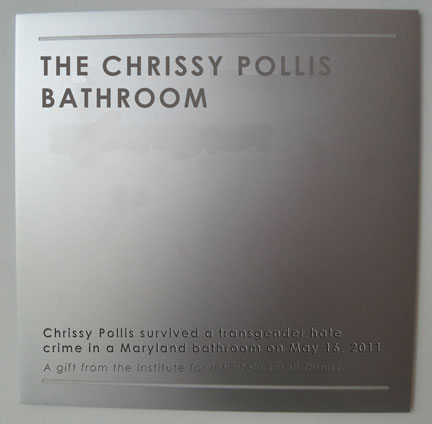
Institute for Infinitely Small Things, “The Chrissy Pollis Bathroom,” plaque.
Photo courtesy of The New England Journal of Aesthetic Research.
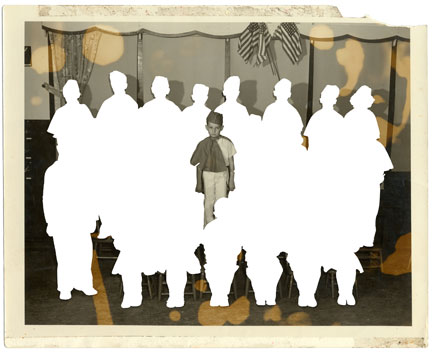
Caleb Cole, “In the Band,” photo from his series “Odd One Out.”
Photo courtesy of The New England Journal of Aesthetic Research.
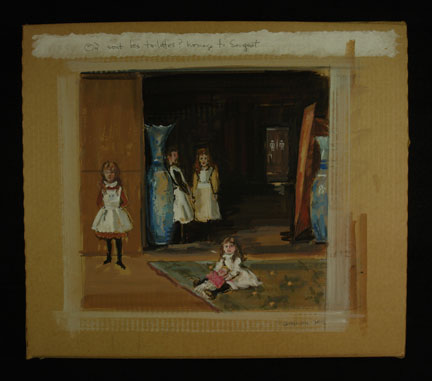
Laura Chasman, “Ou sont les toilettes? Homage to Sargent,” gouache on cardboard box.
Photo courtesy of The New England Journal of Aesthetic Research.
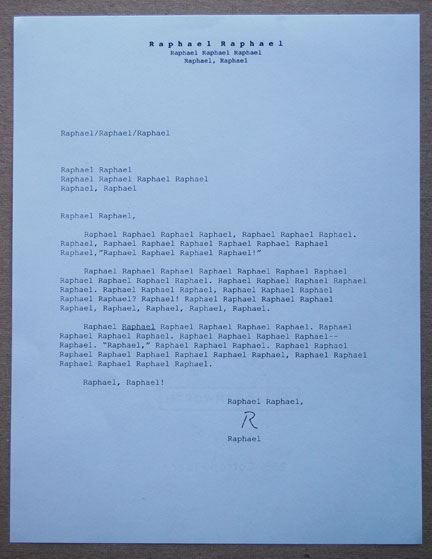
David Raymond, “Raphael,” recreation of work he exhibited in 1971 Flush with the Walls exhibition.
Photo courtesy of The New England Journal of Aesthetic Research.

